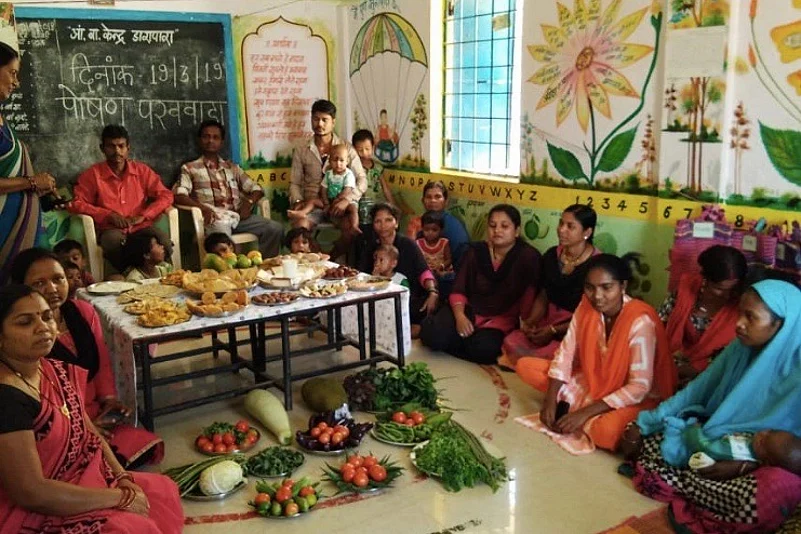Measuring the upper arm circumference of every child every six months, to get an indication of the nutrition levels of the child, and maintaining a chart of the measurement at Anganwadi centres, would go a long way in monitoring of children and tackling malnutrition - in a major step towards the making of Suposhit Bharat.
The Mid-Upper Arm Circumference (MUAC) tape is a plastic strip used to determine malnourishment severity in children between 6 months to 59 months. The tape is wrapped around a child's upper left arm. A measurement in the red zone indicates the child is acutely malnourished, measurement in the yellow zone indicates the child is at risk of malnourishment and green means the child is properly nourished. It is a simple and cheap method that can be effectively used by community workers and parents to track the child’s health.
Advertisement
Dr. P. K. Anand, former Senior Advisor, NITI Aayog, said the MUAC tapes should be given to mothers to measure the nutritional status of their children at home. “We should get age-related MUAC tapes and every six months the child should be measured,” Anand said at a recent conference on Agri-Nutrition here.

Anand also said the National Nutrition Mission or Poshan Abhiyaan should have a “bottoms-up approach”, where none is left behind. He added that in several places many children live in remote areas that are outside the ambit of Anganwadi workers, or their parents are not able to avail of the benefits of government schemes as they do not have Aadhaar cards. Such children and their parents become prey to severe acute malnutrition.
Advertisement
He said the National Family Health Survey 3 and 4 shows that the country is improving its Nutrition Data, but there are still children being left out who are not coming under the radar of Integrated Child Development Services (ICDS) or the Anganwadi services, and this needs to be improved upon.
He also suggested that there should be a chart for measuring over-nutrition or overweight children, to prevent health complications due to obesity.
In order to ensure that the entire community is covered, Anand suggested that a Mother and Child Protection Card (MCP) be used by Anganwadi workers. The card helps in timely identification, referral and management of complications during pregnancy, child birth and post natal period. It also helps to provide complete immunization of infants and children, and on complementary feeding and monitoring the growth of the child.
Anand said the information of MUAC tapes and MCP cards should be monitored regularly. He recommended that Under 5 Mortality Rate and Anaemia trend lines should be available with all officials – right from panchayats, to district magistrates and even the state chief secretaries, for regular monitoring of the children and to ensure they are getting proper nutrition.
Millets are a good way to tackle malnutrition, said Dr. Anand, and suggested that it should be made easier for states to procure millets, which are high in nutritive value compared to wheat and paddy for being included in the Mid Day Meal scheme and for the Public Distribution scheme. The importance of millets, which were once a staple, slid with wheat and rice being made available in the PDS. States need to give more emphasis on the use of millets, he said.
Advertisement
The areas where changes need to be made for the success of Poshan Abhiyaan, are to stress on the Mid Day Meal Scheme and the Integrated Child Development Services, he said. Community kitchens can go a long way in providing diversified nutritious food to people, and can prove to be a “game changer”. He suggested that all eligible children between 0 to 6 years should be covered, as well as pregnant women, lactating mothers and adolescent girls under the ICDS. Under the Mid Day Meal Scheme, all children from 6 to 14 years should be covered.
Anand also suggested that there should be continual monitoring of data, and there should be modernization of data methods. “The data collected at regular intervals will provide a trend of what is happening. There should be real-time data, ICT (Information and Communications Technology) based with real-time tracking and monitoring; there should be SMS alerts for timely action.
Advertisement
“We should track each beneficiary. There should be community-based nutrition monitoring,” Anand suggested, to ensure the success of Poshan Abhiyaan.
India is home to a third of the world’s malnourished children. According to the National Family Health Survey 4 (NFHS 4), 38.4 percent of children in India are stunted and 21 percent wasted.
The Global Hunger Index 2017 ranked India at 100th out of 118 countries.
The government has launched the Poshan Abhiyaan, with fixed goals to reduce low birth weight, stunting and undernutrition (the prevalence of underweight) in children (up to six years of age) by 6% in three years, at the rate of 2% a year; and anaemia among children, adolescent girls and women (up to 49 years of age) by 9%, at the rate of 3% a year.




















